HRM 2: Compensation Issues and Recommendations Report Analysis
VerifiedAdded on 2022/09/15
|6
|1167
|17
Report
AI Summary
This report addresses key issues within human resource compensation, including challenges in determining fair monetary values for loss or injury, designing competitive compensation programs, and managing external competitiveness to retain talent. It also covers issues related to compliance with compensation regulations, internal equity, budget constraints, and transparency. The report then proposes several recommendations to resolve these issues, such as aligning compensation systems with organizational culture, utilizing workforce analytics, negotiating compensation offers, ensuring pay equity, conducting internal audits, recognizing employee contributions beyond monetary rewards, offering flexible incentive plans, and offering competitive compensation packages. The report emphasizes the importance of legal compliance, employee feedback, and a mix of financial and non-financial rewards to improve employee motivation and retention.
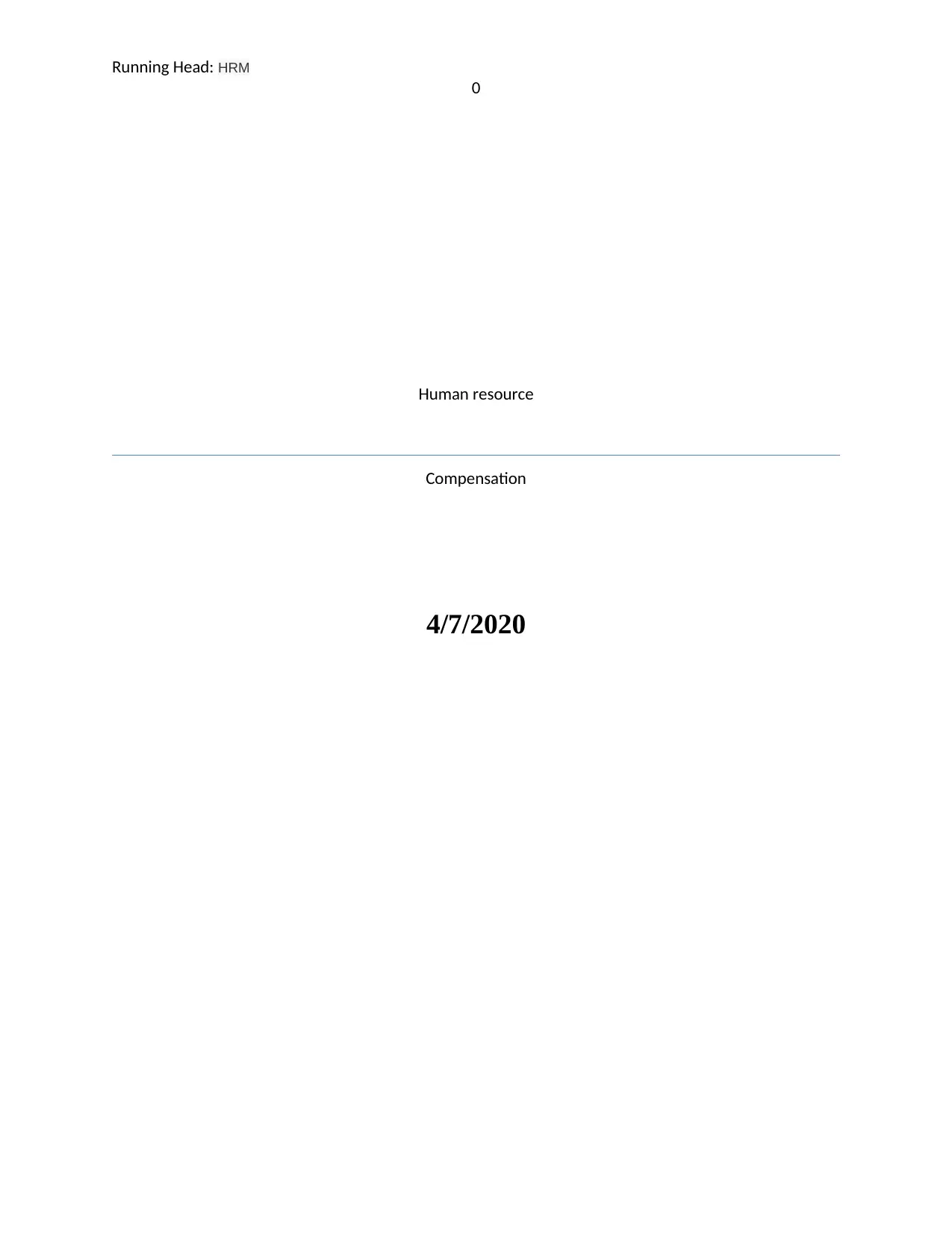
Running Head: HRM
0
Human resource
Compensation
4/7/2020
0
Human resource
Compensation
4/7/2020
Paraphrase This Document
Need a fresh take? Get an instant paraphrase of this document with our AI Paraphraser
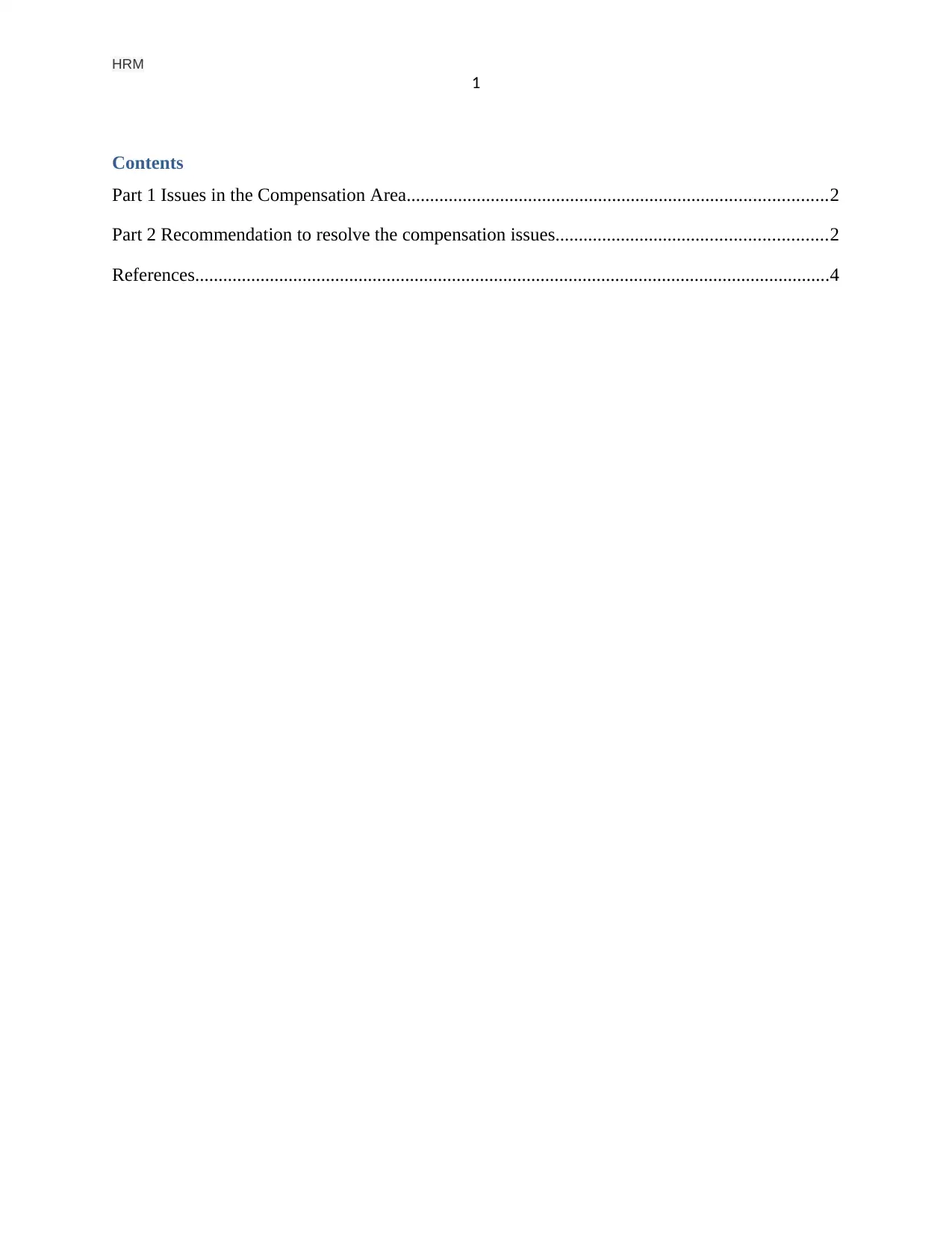
HRM
1
Contents
Part 1 Issues in the Compensation Area..........................................................................................2
Part 2 Recommendation to resolve the compensation issues..........................................................2
References........................................................................................................................................4
1
Contents
Part 1 Issues in the Compensation Area..........................................................................................2
Part 2 Recommendation to resolve the compensation issues..........................................................2
References........................................................................................................................................4
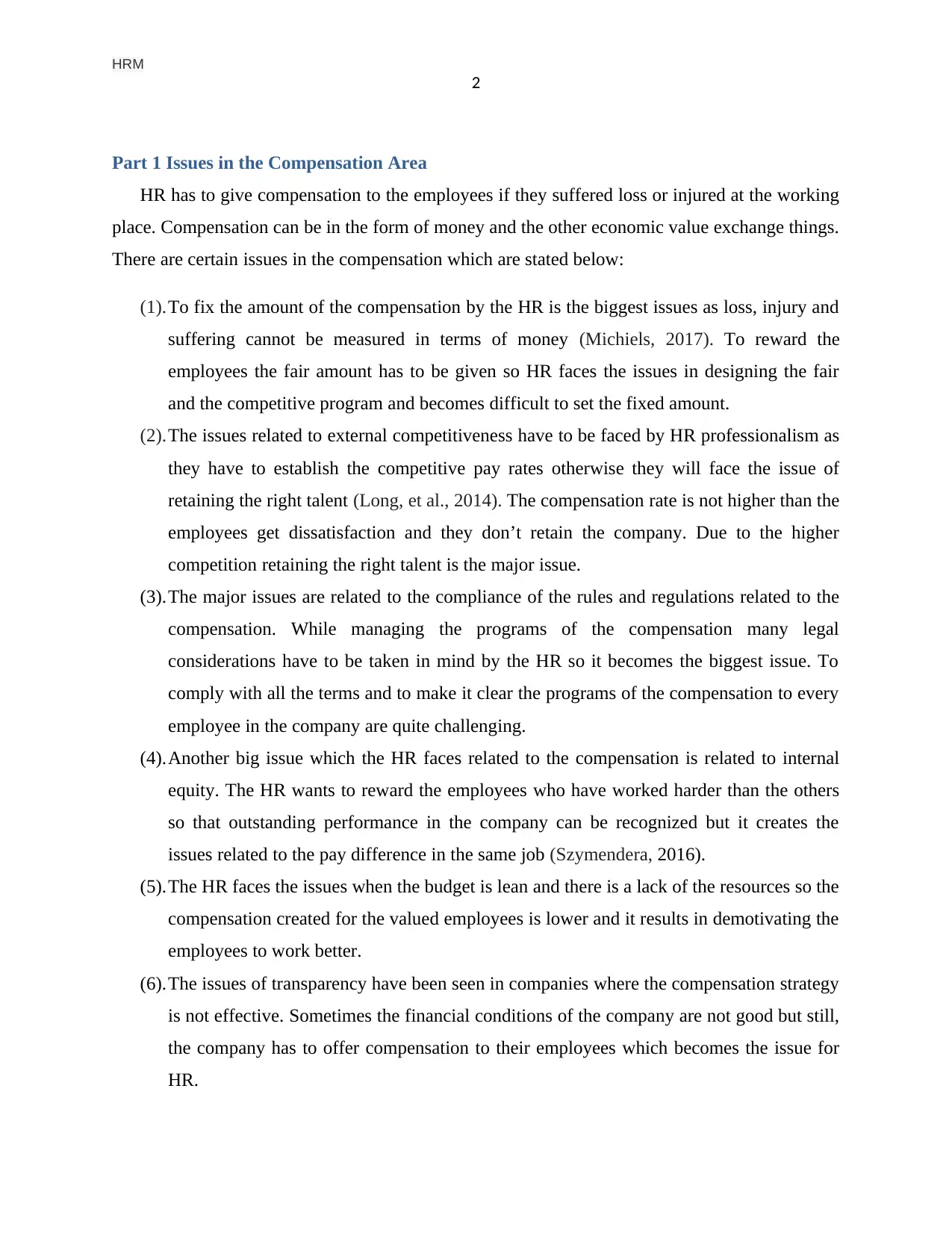
HRM
2
Part 1 Issues in the Compensation Area
HR has to give compensation to the employees if they suffered loss or injured at the working
place. Compensation can be in the form of money and the other economic value exchange things.
There are certain issues in the compensation which are stated below:
(1).To fix the amount of the compensation by the HR is the biggest issues as loss, injury and
suffering cannot be measured in terms of money (Michiels, 2017). To reward the
employees the fair amount has to be given so HR faces the issues in designing the fair
and the competitive program and becomes difficult to set the fixed amount.
(2).The issues related to external competitiveness have to be faced by HR professionalism as
they have to establish the competitive pay rates otherwise they will face the issue of
retaining the right talent (Long, et al., 2014). The compensation rate is not higher than the
employees get dissatisfaction and they don’t retain the company. Due to the higher
competition retaining the right talent is the major issue.
(3).The major issues are related to the compliance of the rules and regulations related to the
compensation. While managing the programs of the compensation many legal
considerations have to be taken in mind by the HR so it becomes the biggest issue. To
comply with all the terms and to make it clear the programs of the compensation to every
employee in the company are quite challenging.
(4).Another big issue which the HR faces related to the compensation is related to internal
equity. The HR wants to reward the employees who have worked harder than the others
so that outstanding performance in the company can be recognized but it creates the
issues related to the pay difference in the same job (Szymendera, 2016).
(5).The HR faces the issues when the budget is lean and there is a lack of the resources so the
compensation created for the valued employees is lower and it results in demotivating the
employees to work better.
(6).The issues of transparency have been seen in companies where the compensation strategy
is not effective. Sometimes the financial conditions of the company are not good but still,
the company has to offer compensation to their employees which becomes the issue for
HR.
2
Part 1 Issues in the Compensation Area
HR has to give compensation to the employees if they suffered loss or injured at the working
place. Compensation can be in the form of money and the other economic value exchange things.
There are certain issues in the compensation which are stated below:
(1).To fix the amount of the compensation by the HR is the biggest issues as loss, injury and
suffering cannot be measured in terms of money (Michiels, 2017). To reward the
employees the fair amount has to be given so HR faces the issues in designing the fair
and the competitive program and becomes difficult to set the fixed amount.
(2).The issues related to external competitiveness have to be faced by HR professionalism as
they have to establish the competitive pay rates otherwise they will face the issue of
retaining the right talent (Long, et al., 2014). The compensation rate is not higher than the
employees get dissatisfaction and they don’t retain the company. Due to the higher
competition retaining the right talent is the major issue.
(3).The major issues are related to the compliance of the rules and regulations related to the
compensation. While managing the programs of the compensation many legal
considerations have to be taken in mind by the HR so it becomes the biggest issue. To
comply with all the terms and to make it clear the programs of the compensation to every
employee in the company are quite challenging.
(4).Another big issue which the HR faces related to the compensation is related to internal
equity. The HR wants to reward the employees who have worked harder than the others
so that outstanding performance in the company can be recognized but it creates the
issues related to the pay difference in the same job (Szymendera, 2016).
(5).The HR faces the issues when the budget is lean and there is a lack of the resources so the
compensation created for the valued employees is lower and it results in demotivating the
employees to work better.
(6).The issues of transparency have been seen in companies where the compensation strategy
is not effective. Sometimes the financial conditions of the company are not good but still,
the company has to offer compensation to their employees which becomes the issue for
HR.
⊘ This is a preview!⊘
Do you want full access?
Subscribe today to unlock all pages.

Trusted by 1+ million students worldwide
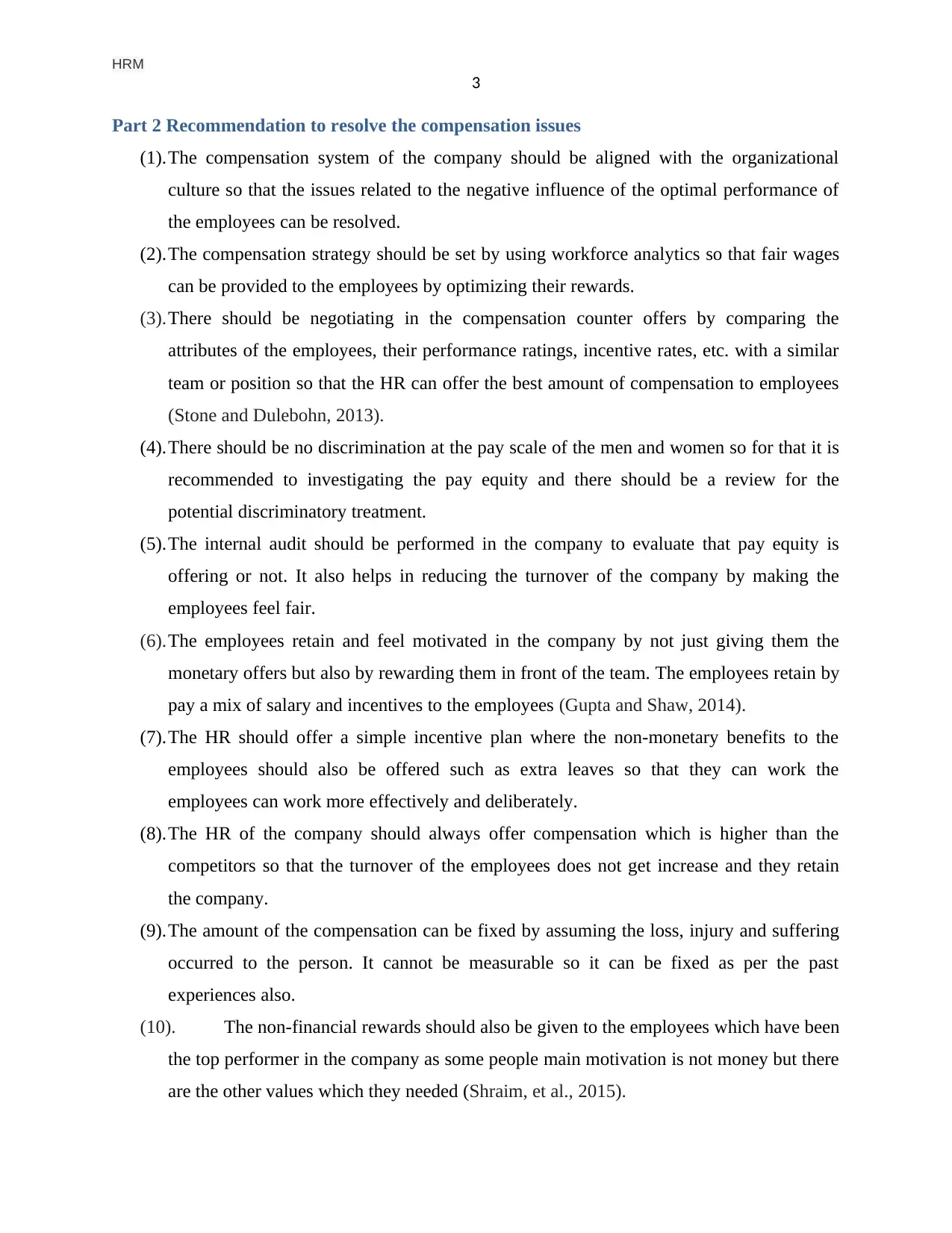
HRM
3
Part 2 Recommendation to resolve the compensation issues
(1).The compensation system of the company should be aligned with the organizational
culture so that the issues related to the negative influence of the optimal performance of
the employees can be resolved.
(2).The compensation strategy should be set by using workforce analytics so that fair wages
can be provided to the employees by optimizing their rewards.
(3).There should be negotiating in the compensation counter offers by comparing the
attributes of the employees, their performance ratings, incentive rates, etc. with a similar
team or position so that the HR can offer the best amount of compensation to employees
(Stone and Dulebohn, 2013).
(4).There should be no discrimination at the pay scale of the men and women so for that it is
recommended to investigating the pay equity and there should be a review for the
potential discriminatory treatment.
(5).The internal audit should be performed in the company to evaluate that pay equity is
offering or not. It also helps in reducing the turnover of the company by making the
employees feel fair.
(6).The employees retain and feel motivated in the company by not just giving them the
monetary offers but also by rewarding them in front of the team. The employees retain by
pay a mix of salary and incentives to the employees (Gupta and Shaw, 2014).
(7).The HR should offer a simple incentive plan where the non-monetary benefits to the
employees should also be offered such as extra leaves so that they can work the
employees can work more effectively and deliberately.
(8).The HR of the company should always offer compensation which is higher than the
competitors so that the turnover of the employees does not get increase and they retain
the company.
(9).The amount of the compensation can be fixed by assuming the loss, injury and suffering
occurred to the person. It cannot be measurable so it can be fixed as per the past
experiences also.
(10). The non-financial rewards should also be given to the employees which have been
the top performer in the company as some people main motivation is not money but there
are the other values which they needed (Shraim, et al., 2015).
3
Part 2 Recommendation to resolve the compensation issues
(1).The compensation system of the company should be aligned with the organizational
culture so that the issues related to the negative influence of the optimal performance of
the employees can be resolved.
(2).The compensation strategy should be set by using workforce analytics so that fair wages
can be provided to the employees by optimizing their rewards.
(3).There should be negotiating in the compensation counter offers by comparing the
attributes of the employees, their performance ratings, incentive rates, etc. with a similar
team or position so that the HR can offer the best amount of compensation to employees
(Stone and Dulebohn, 2013).
(4).There should be no discrimination at the pay scale of the men and women so for that it is
recommended to investigating the pay equity and there should be a review for the
potential discriminatory treatment.
(5).The internal audit should be performed in the company to evaluate that pay equity is
offering or not. It also helps in reducing the turnover of the company by making the
employees feel fair.
(6).The employees retain and feel motivated in the company by not just giving them the
monetary offers but also by rewarding them in front of the team. The employees retain by
pay a mix of salary and incentives to the employees (Gupta and Shaw, 2014).
(7).The HR should offer a simple incentive plan where the non-monetary benefits to the
employees should also be offered such as extra leaves so that they can work the
employees can work more effectively and deliberately.
(8).The HR of the company should always offer compensation which is higher than the
competitors so that the turnover of the employees does not get increase and they retain
the company.
(9).The amount of the compensation can be fixed by assuming the loss, injury and suffering
occurred to the person. It cannot be measurable so it can be fixed as per the past
experiences also.
(10). The non-financial rewards should also be given to the employees which have been
the top performer in the company as some people main motivation is not money but there
are the other values which they needed (Shraim, et al., 2015).
Paraphrase This Document
Need a fresh take? Get an instant paraphrase of this document with our AI Paraphraser
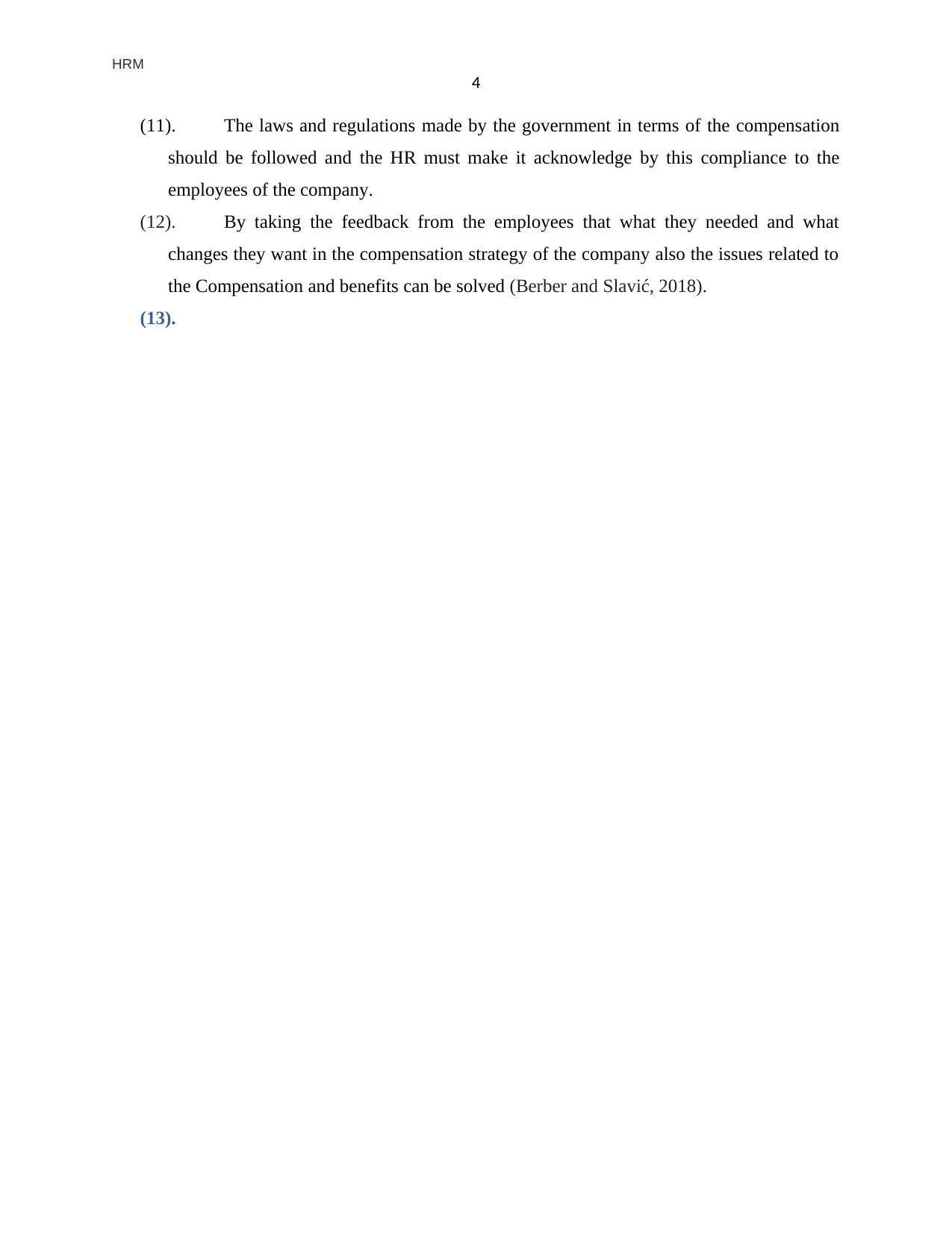
HRM
4
(11). The laws and regulations made by the government in terms of the compensation
should be followed and the HR must make it acknowledge by this compliance to the
employees of the company.
(12). By taking the feedback from the employees that what they needed and what
changes they want in the compensation strategy of the company also the issues related to
the Compensation and benefits can be solved (Berber and Slavić, 2018).
(13).
4
(11). The laws and regulations made by the government in terms of the compensation
should be followed and the HR must make it acknowledge by this compliance to the
employees of the company.
(12). By taking the feedback from the employees that what they needed and what
changes they want in the compensation strategy of the company also the issues related to
the Compensation and benefits can be solved (Berber and Slavić, 2018).
(13).
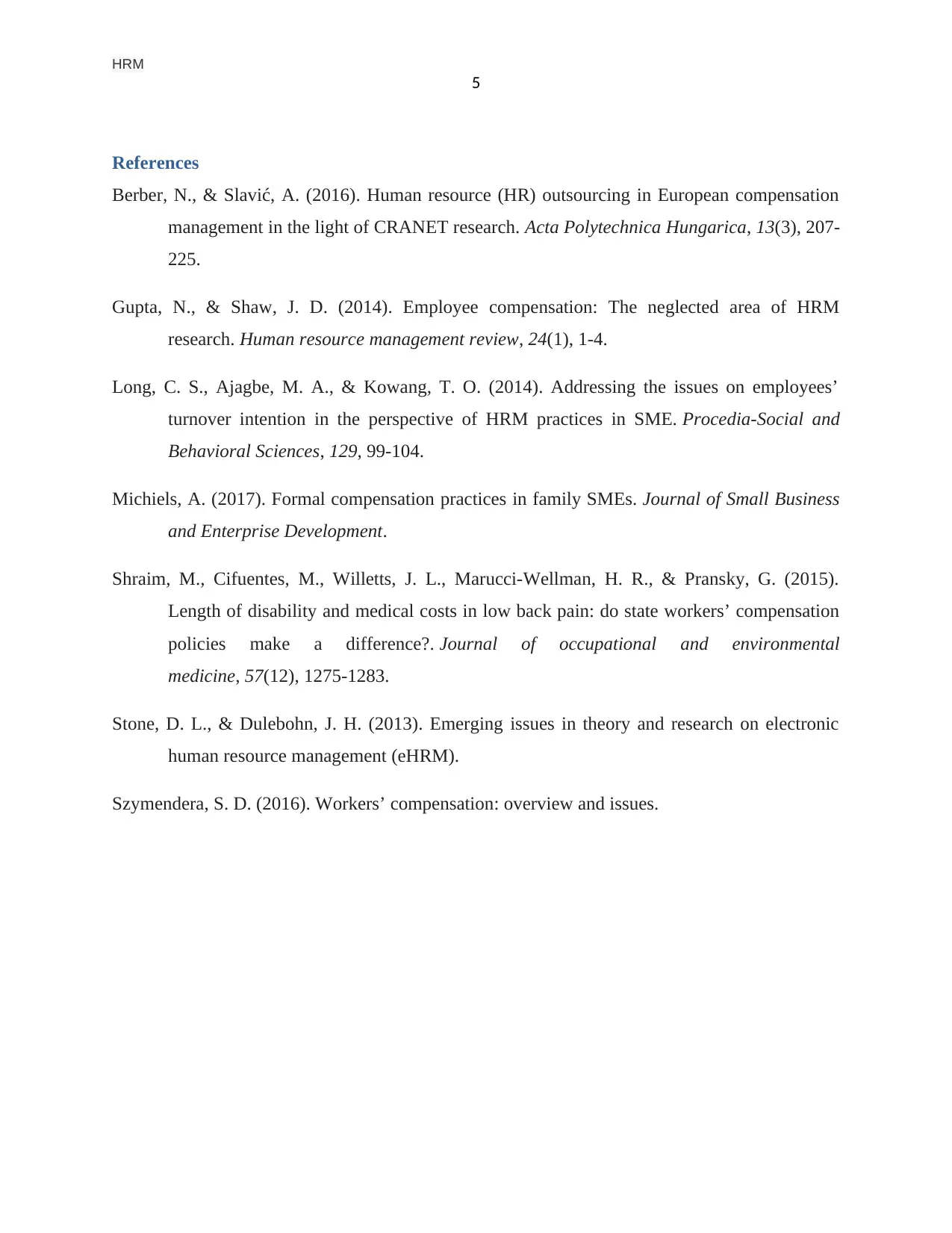
HRM
5
References
Berber, N., & Slavić, A. (2016). Human resource (HR) outsourcing in European compensation
management in the light of CRANET research. Acta Polytechnica Hungarica, 13(3), 207-
225.
Gupta, N., & Shaw, J. D. (2014). Employee compensation: The neglected area of HRM
research. Human resource management review, 24(1), 1-4.
Long, C. S., Ajagbe, M. A., & Kowang, T. O. (2014). Addressing the issues on employees’
turnover intention in the perspective of HRM practices in SME. Procedia-Social and
Behavioral Sciences, 129, 99-104.
Michiels, A. (2017). Formal compensation practices in family SMEs. Journal of Small Business
and Enterprise Development.
Shraim, M., Cifuentes, M., Willetts, J. L., Marucci-Wellman, H. R., & Pransky, G. (2015).
Length of disability and medical costs in low back pain: do state workers’ compensation
policies make a difference?. Journal of occupational and environmental
medicine, 57(12), 1275-1283.
Stone, D. L., & Dulebohn, J. H. (2013). Emerging issues in theory and research on electronic
human resource management (eHRM).
Szymendera, S. D. (2016). Workers’ compensation: overview and issues.
5
References
Berber, N., & Slavić, A. (2016). Human resource (HR) outsourcing in European compensation
management in the light of CRANET research. Acta Polytechnica Hungarica, 13(3), 207-
225.
Gupta, N., & Shaw, J. D. (2014). Employee compensation: The neglected area of HRM
research. Human resource management review, 24(1), 1-4.
Long, C. S., Ajagbe, M. A., & Kowang, T. O. (2014). Addressing the issues on employees’
turnover intention in the perspective of HRM practices in SME. Procedia-Social and
Behavioral Sciences, 129, 99-104.
Michiels, A. (2017). Formal compensation practices in family SMEs. Journal of Small Business
and Enterprise Development.
Shraim, M., Cifuentes, M., Willetts, J. L., Marucci-Wellman, H. R., & Pransky, G. (2015).
Length of disability and medical costs in low back pain: do state workers’ compensation
policies make a difference?. Journal of occupational and environmental
medicine, 57(12), 1275-1283.
Stone, D. L., & Dulebohn, J. H. (2013). Emerging issues in theory and research on electronic
human resource management (eHRM).
Szymendera, S. D. (2016). Workers’ compensation: overview and issues.
⊘ This is a preview!⊘
Do you want full access?
Subscribe today to unlock all pages.

Trusted by 1+ million students worldwide
1 out of 6
Related Documents
Your All-in-One AI-Powered Toolkit for Academic Success.
+13062052269
info@desklib.com
Available 24*7 on WhatsApp / Email
![[object Object]](/_next/static/media/star-bottom.7253800d.svg)
Unlock your academic potential
Copyright © 2020–2025 A2Z Services. All Rights Reserved. Developed and managed by ZUCOL.





